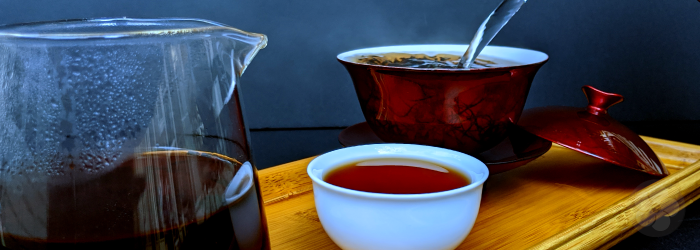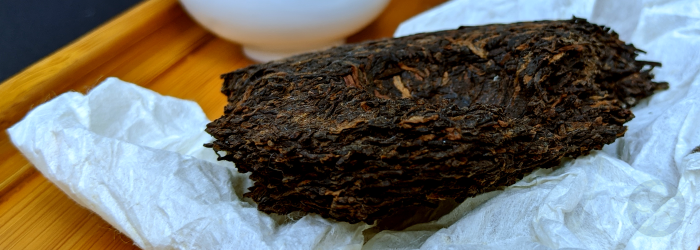Tasting Notes: Why Do Some Pu-erh Teas Taste Fishy?

The unusual category of pu-erh tea can be a divisive topic. Though loved and lauded by many die-hard connoisseurs, the unique flavor profile produced by microbial fermentation is unlike any other tea, and can be off-putting to new drinkers. Fans savor the bold, earthy flavors this style is known for, and appreciate the notes of peat, loam, and petrichor that make pu-erh teas so distinctive. But with popularity increasing worldwide for this tea from remote Yunnan Province, the market’s demand for inexpensive pu-erh tea has led to many examples that fall short of quality flavor.
Find out what makes pu-erh tea different from other tea types >>
Rather than the rich, earthy tones that pu-erh lovers search for, these all-too-common teas often have a distinctive ‘fishy’ note to their flavor. It’s no wonder that many novice pu-erh buyers are left with a bad impression, when their first exposure to the category is one of these. Sometimes, it is enough to turn a palate away from pu-erh entirely! So what gives some pu-erh teas this unpleasant fishiness? Can a tea with this flavor profile be salvaged? How can consumers avoid the disappointment of fishy flavor, especially when buying online? We’ve got answers to all these questions in this post.
Learn more about the basics of pu-erh tea with Alice in this video:
Fresh Shou Pu-erh
Developed in the 1980’s to meet the rising demand for aged tea without requiring long-term aging, the ‘cooked’ or shou style of pu-erh uses an accelerated fermentation process to create the classic pu-erh flavor profile. While this is by far the most common style of pu-erh tea on the market today, it is also the most likely to have fishy flavor notes. In fact, almost every shou pu-erh displays these characteristics when freshly crafted.
Explore the difference between shou and sheng pu-erhs >>
Luckily, with proper storage, most shou pu-erhs lose this quality after a relatively short aging period. Most serious factories and vendors will hold freshly fermented harvests until they have settled to ensure that these young teas don’t tarnish the reputation of their stock. The only pu-erh teas that should be purchased within the first year or two of harvesting are ‘green’ pu-erh teas, which have not undergone fermentation at all. Though these teas are sometimes considered maocha and may have aging potential for dedicated collectors, they are generally meant to be consumed while fresh.
Low-Quality Pu-erh
Sometimes, however, pu-erh develops fishy flavor notes when it is poorly handled during the process of fermentation, or during long-term storage. These lower quality teas are less likely to “age out” of their unpleasant flavor notes, since they are typically the result of undesirable microbes within the tea. Breaking up tea cakes into smaller pieces or allowing for plentiful airflow can occasionally improve the flavor, but there are no guarantees that these teas will improve with continued storage.
Learn more about the difference between pressed cakes and looseleaf pu-erh >>
During the process of accelerated fermentation used to create shou pu-erhs, most factories use a ‘starter’ culture consisting of a previous batch of tea, or otherwise introduce the right microbes to create their desired flavor profile. While the tea is fermenting in large piles, proper hygiene within the factory is key to maintaining this proper microbial culture. If a processing facility accidentally introduces the wrong microbes during fermentation, they can overtake the introduced culture and create unpleasant flavor notes like the familiar fishy odor.
Sheng pu-erhs, which are aged naturally over at least 10 years before they are considered ready to drink, typically avoid this problem, since they ferment more slowly. Without the heat and moisture generated in the shou piling process, they are significantly less likely to nurture the microbial cultures that create fishy notes. However, poor storage is also a potential source of unpleasant flavor profiles. If pu-erh teas, sheng or shou, are stored without proper air circulation, they are more likely to develop flavors that taste ‘off’, whether fishy or otherwise. In general, pu-erhs should never be wrapped in sealed plastic or stored in humid environments without regular redistribution for airflow.
Find out how storage conditions affect pu-erh flavor >>
How to Avoid Fishy Pu-erhs
Focusing on well-aged pu-erhs is generally a good way to avoid the bulk of mass market pu-erh teas prone to fishy flavors, but it is usually more expensive, and not a guarantee of responsible storage. Though sometimes disdained by true aficionados, loose leaf pu-erh teas are often a safer bet than pressed shou cakes, since they allow for more airflow and can typically be purchased in smaller quantities.
In general, though, the same rules apply to buying pu-erh as to any other style of tea: taste or sample whenever possible to verify quality before committing to a larger amount. In the absence of a tasting or sample size, be sure to buy from trusted vendors that offer as much information as possible about their teas.
Finally, keep in mind that a poor example of pu-erh flavor doesn’t necessarily represent the entire category! Pu-erh is one of the most diverse styles of tea, with flavor notes that can range from crisp and fruity to rich and hearty. Keep exploring to find the perfect pu-erh for your palate.
Have you tasted a ‘fishy’ pu-erh? Tell us about your experience in the comments below!
Sign up for our newsletter to get blog updates in your inbox!






Comments on this post (0)